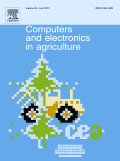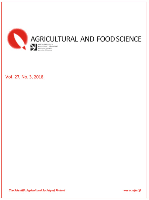
COMPUTERS AND ELECTRONICS IN AGRICULTURE
Scope & Guideline
Exploring New Frontiers in Agri-Tech
Introduction
Aims and Scopes
- Precision Agriculture:
The journal covers advancements in precision agriculture technologies, including remote sensing, GPS, and IoT applications that optimize farming practices and resource management. - Agricultural Robotics:
Research on robotic systems for tasks such as planting, harvesting, and monitoring crops is a core focus, exploring how automation can improve efficiency and reduce labor costs. - Data Analytics and Machine Learning:
The journal emphasizes the use of machine learning and data analytics for modeling agricultural processes, predicting outcomes, and improving decision-making in farming. - Crop and Soil Sensing Technologies:
Innovations in sensor technologies for monitoring soil health, crop growth, and environmental conditions are highlighted, showcasing methods that enhance data collection and real-time analysis. - Sustainable Practices:
Research aimed at promoting sustainable agricultural practices through technology, including water management, pest control, and resource-efficient farming methods, is a key area of interest. - Agricultural Informatics:
The journal explores the integration of information systems in agriculture, including the use of big data, cloud computing, and smart farming technologies.
Trending and Emerging
- Artificial Intelligence and Deep Learning:
There is a significant increase in research utilizing AI and deep learning techniques for crop monitoring, disease detection, and yield prediction, reflecting the growing integration of these technologies in agriculture. - Remote Sensing and UAV Technology:
The use of drones and remote sensing technologies for precision agriculture is rapidly trending, with numerous studies focusing on their applications in crop health assessment and environmental monitoring. - Sustainable Agricultural Practices:
Research on sustainable agriculture practices, including resource conservation and eco-friendly pest management, is gaining momentum as the sector increasingly prioritizes sustainability. - IoT and Smart Farming Solutions:
The emergence of IoT technologies in agriculture is a trending topic, with research focusing on connected devices that enhance farm management and operational efficiency. - Data-Driven Decision Making:
There is an emphasis on the use of big data and analytics for making informed decisions in agriculture, reflecting a shift towards data-centric farming practices. - Integration of Blockchain Technology:
The application of blockchain for traceability and transparency in the agricultural supply chain is an emerging theme, driven by the demand for food safety and quality assurance.
Declining or Waning
- Traditional Farming Techniques:
There is a noticeable decline in research focused on traditional farming methods, as the emphasis shifts towards technologically advanced practices and automation. - Manual Labor in Agriculture:
Research topics related to manual labor in farming are waning as the industry increasingly adopts robotic solutions and automated systems. - Basic Agricultural Equipment:
There has been a decrease in publications related to conventional agricultural equipment, with more focus on smart machinery and integrated systems. - Static Data Analysis:
Static methods of data analysis are becoming less common, with a shift towards dynamic, real-time data processing and predictive analytics. - General Agricultural Education:
While foundational agricultural education remains important, the journal has seen fewer articles focusing on traditional educational approaches, favoring those that incorporate technology and innovation.
Similar Journals

Agrosystems Geosciences & Environment
Advancing sustainable practices in agrosystems and geosciences.Agrosystems Geosciences & Environment, published by WILEY, is a premier open access journal dedicated to advancing the interdisciplinary field of agricultural and environmental sciences. With an E-ISSN of 2639-6696, the journal has gained recognition since its inception in 2018, currently holding a Q2 ranking in Agricultural and Biological Sciences, Plant Science, and Soil Science. Operating from the United Kingdom, Agrosystems Geosciences & Environment contributes significantly to knowledge generation and dissemination, offering vital insights into sustainable practices, soil management, and crop optimization. Researchers and professionals will find the open access model particularly advantageous, promoting greater visibility and engagement within the scientific community. By bridging the gap between geosciences and agrosystem management, this journal is vital for those committed to addressing today's critical environmental challenges.

Journal of Agricultural Machinery
Unlocking the Future of Farming with Innovative Machinery StudiesJournal of Agricultural Machinery, published by FERDOWSI UNIVERSITY MASHHAD PRESS, is a premier Open Access journal that has been serving the agricultural engineering community since 2011. This journal is dedicated to disseminating cutting-edge research, innovative practices, and technological advancements related to agricultural machinery. With an ISSN of 2228-6829 and an E-ISSN of 2423-3943, it provides a vital platform for researchers and professionals in the field to share their findings and insights. The journal, based in Iran at the Ferdowsi University of Mashhad, aims to bridge gaps between research and application, enhancing productivity in agriculture through improved machinery and methodologies. Despite its current Scopus ranking at the lower end of the spectrum, the journal is committed to elevating its impact and expanding its scope, focusing on innovative solutions that address pressing challenges in agricultural practices. As an Open Access resource, it ensures unrestricted availability to scholarly articles, fostering a collaborative environment for growth and learning among researchers, professionals, and students alike.

AGRICULTURAL AND FOOD SCIENCE
Fostering interdisciplinary insights for a thriving agricultural sector.AGRICULTURAL AND FOOD SCIENCE is a prestigious journal published by the SCIENTIFIC AGRICULTURAL SOCIETY OF FINLAND, dedicated to advancing knowledge in the fields of agricultural and food sciences. With an ISSN of 1459-6067 and E-ISSN of 1795-1895, this open-access journal has been providing valuable insights and research findings since its inception in 2002. As of 2023, it holds a Q3 ranking in Food Science and is positioned at the 46th percentile within its Scopus category, ranking 210 out of 389 journals in Agricultural and Biological Sciences – Food Science. The journal features contributions from a global network of researchers, covering various topics including sustainable agricultural practices, food safety, and innovative food technologies. Based in Finland, the journal serves as an essential platform for scholars, professionals, and students who are committed to enhancing food security and agricultural productivity through rigorous scientific research. The convergence of interdisciplinary studies from 2004 to 2024 marks a critical evolution in the scope of agricultural and food research, making this journal a vital resource for anyone involved in these dynamic fields.

Transactions of the ASABE
Advancing sustainable solutions in agricultural engineering.Transactions of the ASABE is a premier journal published by the American Society of Agricultural and Biological Engineers, specializing in innovative research and practical applications in the fields of agricultural and biological engineering. With an ISSN of 2151-0032 and E-ISSN 2151-0040, this journal has established a vital niche in disseminating high-quality scholarly content that addresses the complex challenges faced in agriculture and biological systems. The journal operates under an open access model, facilitating broad dissemination of research findings to a global audience. This commitment to accessibility is reflected in its coverage of diverse topics, including agriculture, soil science, food science, and environmental engineering. Although the journal's coverage in Scopus was discontinued in 2021, it once ranked among the top in its categories, indicating its significant contribution to advancing knowledge in these essential fields. Researchers, practitioners, and students are encouraged to engage with the Transactions of the ASABE to stay abreast of developments and foster collaboration in promoting sustainable engineering solutions.

Agricultural & Environmental Letters
Exploring the intersection of agriculture and environmental stewardship.Agricultural & Environmental Letters, published by WILEY, is an esteemed open-access journal dedicated to advancing knowledge in the fields of agronomy, environmental science, and soil science. Since its inception in 2016, the journal has provided a vital platform for researchers, professionals, and students to contribute to critical discussions on sustainable agricultural practices and environmental management. With an impressive 2023 impact factor placed in the Q2 category across various fields—namely Agronomy and Crop Science, Management, Monitoring, Policy and Law, and Soil Science—this journal occupies a significant position in academic discourse. The journal’s Scopus rankings further attest to its influential role; it ranks in the top half of its categories, reflecting the quality and relevance of the research published within. Agricultural & Environmental Letters welcomes innovative research articles, reviews, and empirical studies focusing on pressing environmental and agricultural issues, ensuring accessibility for a global audience committed to sustainability in agriculture and environmental stewardship.

AGROCIENCIA
Driving progress in agronomy and environmental science.AGROCIENCIA, published by COLEGIO POSTGRADUADOS, is a key journal in the fields of agronomy, animal science, and environmental science in Mexico. With an ISSN of 1405-3195 and an E-ISSN of 2521-9766, this journal has been a crucial platform for disseminating research findings since its inception in 2000. Operating from Montecillo, Estado Mexico, it provides an outlet for scholars and practitioners to share innovations and insights that directly impact agricultural practices and environmental sustainability. Despite its current categorization in the Q4 quartile across multiple disciplines, AGROCIENCIA strives to elevate the quality and reach of research, fostering a collaborative approach to tackle pressing issues within the agricultural sciences. Access options are primarily through institutional subscriptions, allowing for a diverse audience of researchers, professionals, and students to engage with the latest studies aimed at advancing knowledge in the agricultural sector. As the journal converges towards its 2024 milestone, it remains dedicated to enhancing scientific inquiry and promoting effective solutions within its discipline.

Artificial Intelligence in Agriculture
Transforming Agriculture Through Intelligent InnovationArtificial Intelligence in Agriculture is a premier open-access journal dedicated to advancing the application of artificial intelligence technologies in the agricultural sector. Published by KEAI Publishing Ltd in China, this journal has rapidly gained recognition since its inception in 2019, boasting an impressive impact factor highlighted by its Q1 rankings across multiple categories in the 2023 Scopus metrics. Aimed at researchers, practitioners, and students alike, it provides a vital platform for disseminating innovative research and practical applications that bridge the gap between AI and agriculture. With a focus on enhancing productivity through cutting-edge AI methodologies, the journal encourages submissions that address the multifaceted challenges in agricultural practices. Whether you are looking to publish your work or explore the latest findings, Artificial Intelligence in Agriculture is an essential resource for anyone committed to fostering sustainable agricultural advancements through technology.

Smart Agricultural Technology
Pioneering Interdisciplinary Research in Smart AgricultureSmart Agricultural Technology, an esteemed journal published by ELSEVIER, stands at the forefront of agricultural innovation, with its focus on the intersection of cutting-edge technology and sustainable farming practices. Established in 2021, this Open Access journal is committed to disseminating pivotal research findings in the fields of Agricultural and Biological Sciences, Artificial Intelligence, and Computer Science, ensuring that crucial developments are accessible to all stakeholders. With a notable impact factor denoted by its impressive Q1 and Q2 categorizations, Smart Agricultural Technology ranks among the top journals in its fields, boasting a percentile standing of 76th in Agricultural and Biological Sciences and 68th in Computer Science advancements. Operating out of the Netherlands, the journal offers a dynamic platform for researchers, professionals, and students to explore, share, and drive forward the agenda of smart agriculture through vital interdisciplinary collaboration and knowledge dissemination. Featured in Scopus, it promises not only rigor and excellence but also a vibrant forum for groundbreaking ideas and practices that can transform the agricultural landscape.

Journal of the ASABE
Pioneering Insights for a Sustainable Agricultural LandscapeJournal of the ASABE, published by the American Society of Agricultural and Biological Engineers, serves as a pivotal platform for disseminating cutting-edge research in various disciplines, including Agronomy, Crop Science, Biomedical Engineering, Food Science, Forestry, and Soil Science. With an impact factor that reflects its significance and reach, the journal ranks in the Q2 and Q3 quartiles across numerous categories in 2023, showcasing its commitment to advancing knowledge in agricultural and biological engineering. Authored by leading experts, the journal offers accessible articles on innovative methodologies, technologies, and sustainable practices essential to the global agricultural and environmental landscape. Open access options ensure that research findings are readily available to a broad audience, promoting collaboration and knowledge sharing among researchers, professionals, and students alike. With a strategic focus on research convergence into 2024, Journal of the ASABE is poised to shape the future of engineering solutions in agriculture and beyond.

Engenharia Agricola
Empowering global agricultural practices through open access.Engenharia Agricola, published by the SOC BRASIL ENGENHARIA AGRICOLA, is a crucial open-access journal that has been at the forefront of agricultural engineering research since its inception in 1981. With an E-ISSN of 1809-4430 and an ISSN of 0100-6916, this journal stands out in the field by providing a platform for disseminating innovative studies and advancements in agricultural practices and technologies. Based in Brazil, the journal emphasizes global perspectives in agricultural and biological sciences, currently positioned in the Q3 quartile of its category, as recognized in the 2023 Scopus Ranks, where it ranks 97 out of 193 publications. Researchers, professionals, and students can access a plethora of high-quality articles that contribute to sustainable agronomy, agricultural mechanics, and resource efficiency across various environments, with open access since 2004, ensuring that critical knowledge is readily available to all stakeholders in the field.